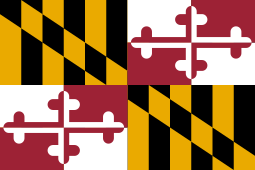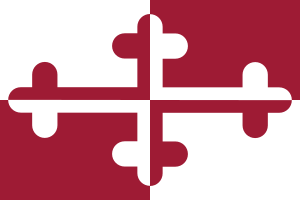Flag of Maryland facts for kids
 |
|
| Use | Civil and state flag |
|---|---|
| Proportion | Unidentified |
| Adopted | March 9, 1904 |
| Design | Heraldic banner of Cecil Calvert, 2nd Baron Baltimore |
The flag of the state of Maryland is a special symbol with a long history. It comes from the family crest, or heraldic banner of arms, of Cecil, the 2nd Baron Baltimore. This flag shows parts of the family shield of his father, George, the 1st Baron Baltimore (who lived from 1579 to 1632). It also includes designs from his grandmother's family, the Crosslands, from England. The Maryland General Assembly, which is the state's law-making group, officially adopted this flag in 1904.
Contents
Older Flag Designs
Maryland's first flag design was simpler. It showed the Seal of Maryland on a blue background. Many other U.S. state flags look similar to this older design.
What the Flag Looks Like
The current Maryland flag has two main parts. The black and gold design comes from the Calvert family's coat of arms. This design was given to George Calvert as a reward for being brave in a battle. The vertical bars on this part of the flag look like the strong wooden fences, called palisades, used in old forts.
The red and white design is from the Crossland family's coat of arms. This was the family of Lord Baltimore's mother. It features a special cross called a cross bottony, where the red and white parts of the cross switch places. Because George Calvert's mother was an heiress, he was allowed to use both family designs on his banner.
Maryland's flag is one of only four U.S. state flags that does not use the color blue. The others are Alabama, California, and New Mexico. It's also the only U.S. state flag directly based on English family crests.
A Flag with History
The Maryland colony was started by Cecilius Calvert, the second Baron and Lord Baltimore. King Charles I of England gave him this land because he was George Calvert's son. That's why his family's coat of arms is on the flag.
At first, only the gold and black Calvert arms were linked to Maryland. These were brought back into use in 1854. The red and white Crossland family arms became popular during the American Civil War. During this war, Maryland stayed with the Union, but many people in the state supported the Confederacy.
Marylanders who supported the Confederacy often used the red and white Crossland banner. They sometimes even wore a metal cross bottony on their uniforms. On the other hand, Union Army groups in Maryland used the black and gold Calvert colors.
After the war, people from both sides returned to Maryland. They needed to find a way to come together again. The current flag design, which combines both the Calvert and Crossland coats of arms, started to appear. At first, the Crossland part was in the top-left corner, but it was later swapped with the Calvert arms after the Union won the war.
The flag as we know it today was first flown on October 11, 1880, in Baltimore. This was during a parade celebrating Baltimore's 150th birthday. It was also flown in 1888 at the Gettysburg Battlefield to honor Maryland soldiers who fought for the Union. However, it wasn't officially made the state flag until 1904.
In 2001, a group called the North American Vexillological Association ranked Maryland's flag as the fourth best in design quality among 72 flags from U.S. states, Canadian provinces, and U.S. territories.
Special Flagpole Rules
Maryland is the only U.S. state with specific rules not just for how to display its flag, but also for what the flagpole should look like. In 1945, the Maryland General Assembly decided that a gold cross bottony should be the official decoration at the very top of any flagpole carrying the state flag.
Most state government buildings, including public schools, follow this rule. However, many private citizens and businesses do not.
Where You See the Flag
The Calvert and Crossland designs, and the flag itself, are used in many different ways across Maryland.
- The University of Maryland often paints both end zones at Maryland Stadium with the flag's two patterns.
- Many Maryland counties and cities, like Baltimore City and Calvert County, use parts of the flag in their own symbols.
- The University of Maryland, College Park athletic teams use all four flag colors: red, white, black, and gold. The Maryland flag is also often displayed on their football uniforms.
- The University of Maryland, Baltimore County (UMBC) also uses all four colors in its main logo.
- The shield of Loyola University Maryland includes the Calvert shield and a design inspired by the Maryland flag.
- The seal of The Johns Hopkins University in Baltimore features the same design and colors as the Maryland flag.
- The secondary logo of the Baltimore Ravens professional football team uses a shield with parts of the Calvert and Crossland banners.
- Starting in 2009, the Baltimore Orioles baseball team added a patch of the Maryland flag to the left arm of their uniforms.
- Southwest Airlines painted one of its Boeing 737 airplanes with a Maryland state flag theme in 2005. This plane is called Maryland One.
- From 1986 to 2010, Maryland's license plates had the flag's unique design in the center.
- Many popular items, like car bumper stickers, shirts, and keychains, feature the flag's design.
- The school colors of Calvert School in Baltimore City are black and gold.
- The Maryland-based company Under Armour has released shoes and bags that include the flag's design.
Images for kids
-
The Maryland state flag flying alongside the U.S. flag in March 2008.
-
Governor Larry Hogan wearing a flag mask during the COVID-19 pandemic
-
Key sculpture in Frederick, Maryland
-
Governor Larry Hogan (right) and former Baltimore mayor Catherine Pugh (2nd from left) wearing state flag apparel
See also
 In Spanish: Bandera de Maryland para niños
In Spanish: Bandera de Maryland para niños














